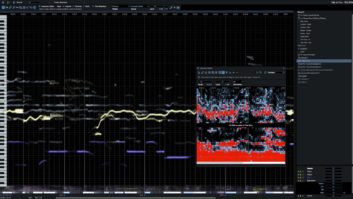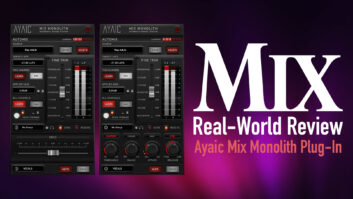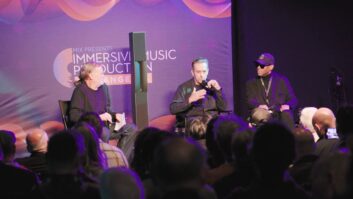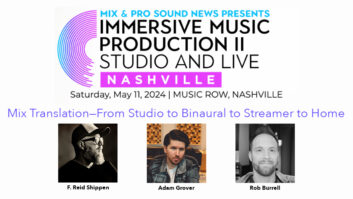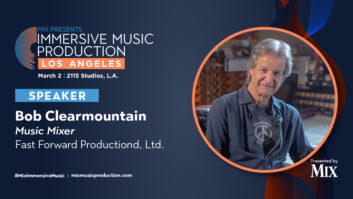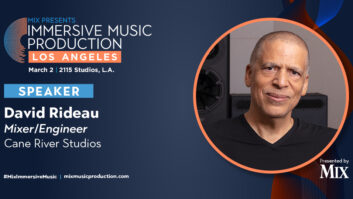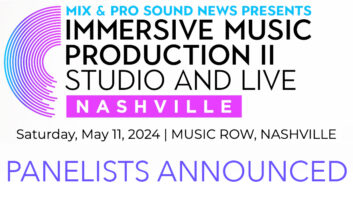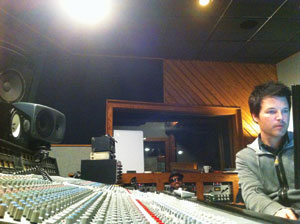
Eric Jarvis, president of the Texas chapter of the Recording Academy, turned Mix on to CJ Eiriksson. We had asked about Austin, and he came back with a list of what’s going on, who’s hot. “CJ might be the ideal subject,” he said, “He’s starting to write a lot, too, with everyone from Alien Ant Farm to up-and-coming Austin hip-hop artist Zeale.”
The Canadian-born Eiriksson, after a stop in Los Angeles, has settled in to Austin and its music scene, while continuing to work far and wide. The producer/mixer/engineer/songwriter, managed by Sandy Roberton of World’s End, has a discography that includes U2, Matchbox Twenty, Jack’s Mannequin, The Rocket Summer, Hoobastank, LIVE, Incubus, Phish and many, many more. He’s also governor for the Texas chapter of the Recording Academy. We asked him to answer a few questions about what he’s seeing in and around town these days, and how he likes to work.
You seem to have this knack for working with major artists and up-and-comers/locals. How would you describe the basic differences in the approach to recording?
I work with the same drive and passion with any artist, whether it’s Bono or a kid recording in his bedroom. Obviously, having a big budget can make the studios a lot nicer, and lunches tastier, but music is music; every successful musician at one point was unknown. I have worked with several bands that went from just starting out to huge success over the years, including Incubus and Hoobastank, so I’ve seen first hand that no one is born a famous rock star, but anyone has the potential. Sometimes it’s nice to have lots of time to work, but I almost prefer to have limitations. It gives you a sense of urgency to commit and get things done; over-thinking is the enemy of music.
I also notice that while you work in a wide variety of genres, you seem to have an affinity for rock. How do you get a great electric guitar sound, from mic to pre to effects to mix?
I am a fan of all music, including some Austin hip-hop I’m currently producing/writing, like breaking-out artist Zeale or the duo RAS, Riders Against the Storm. But I definitely have had a lot busier career in the rock/pop world. I tend to keep things simple when recording electric guitars, usually just a 57 and a Royer 121 pretty close-up, straight and a 45-degree angle, into either a Neve or API mic pre, sometimes busing both together through a compressor, like an LA2A if its more of a lead part. Then I commit both sounds to one channel. I tend to mix as I’m recording, always looking toward the big picture, making decisions and not leaving too many questions for later. If you work quickly and get a lot done fast, it’s really easy to sit back afterwards and see what the song needs or is missing.
How do you approach a rock male vocal? A singer-songwriter vocal? Do you like them in the room, a booth?
I’m a fan of quite a bit of compression for vocals, again with a Neve or API pre, followed by an 1176 compressor, as well as a limiter to keep things steady, usually an LA3A or LA2A. I want to be able to feel that vocalist up close, hear every vowel and nuance of a vocal, so it sits right up nice in the mix. An old tube mic like a Telefunken U 47/48 is always great, but I’m not at all against having a singer get loud and proud in the control room with a 58, cranking the studio monitors and giving the vocalist a nice exciting vibe to sing in. Recording and being in the studio to me is all about feeling comfortable and having fun. This will always come across in the performances. Anyone in music is pretty lucky to be doing this, we should always be having a good time I think. I can make anything sound good, fix notes, timing, whatever needed with Pro Tools, but there is no plug-in for a great performance!
Austin is forever pushed as the “live music capital of the world.” How does that influence the local studio scene?
Austin has an amazing, vibrant music scene. I have a pool of local musicians who are all good friends and super easy to get whatever I need done. I think that just about everybody plays guitar in Austin! When it comes to tracking, I am a fan of getting the band all set up, playing together and making sure tempos are good, but then really focusing first on getting drums, and go through each musician individually, fine tuning their parts, tones etc. There is probably a lot of “live off the floor” tracking being done in Austin, but that’s not always how I roll. I like to make sure everything everyone does really counts.
Where do you like to work in town? And why?
The music scene, along with the great amount of really good, reasonably priced studios, is what made me move here seven years ago. Places like The Wire, the newer one Austin Signal, and classics like the newly renovated Arlyn/Pedernales studios in the heart of the city—all great and my go-to places depending on what vibe/gear I’m looking for. Sometimes I may want to use an API desk, others only Neve pre’s, or I can mix on the SSL at Arlyn.
I mostly mix at a semi-private studio just outside Austin on a friend’s beautiful ranch, called BlueWorld Music. The setup there is a mixture of old and new school, Dangerous summing mixers, but a ton of classic outboard gear that is all normalized in the outputs. When I mix, I like to work fast, get the songs to a really good place quickly, then let the artist listen and give input, and follow up with recalls until its right, which is usually in one or two more passes. I always keep all my outboard at exactly the same settings, then do all my moves—any extra EQ, compression, effects—in the box for each song This way I can literally go through a whole album’s worth of songs a couple times in a day quite easily. I use a lot of plug-ins for mixing; I don’t think I could mix without Waves…
At the end of the day though, the most important thing is the song. We are making music for people to enjoy, and there is no better feeling in this business then to create a song that people love, relate to, and live their lives through the music. That’s why I do this. I love music and how it makes me feel. I want to make others feel the same!

